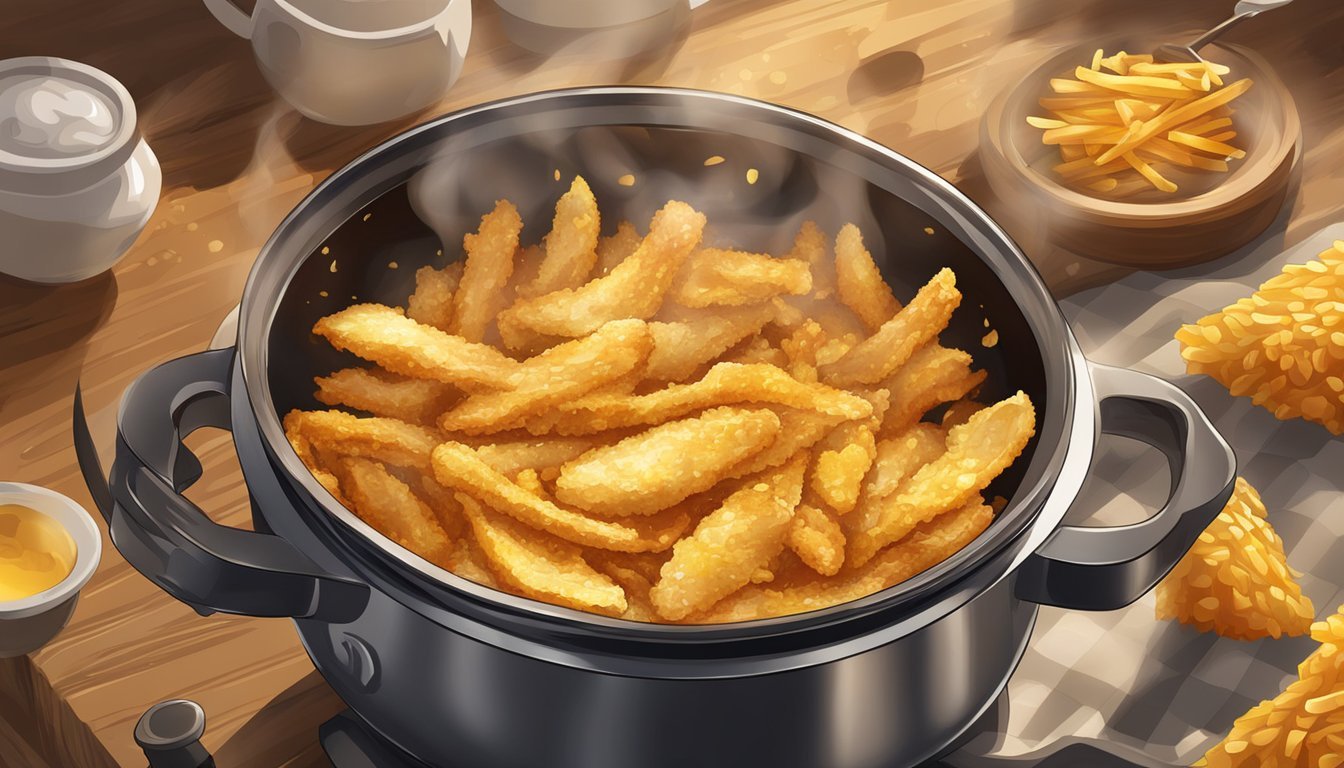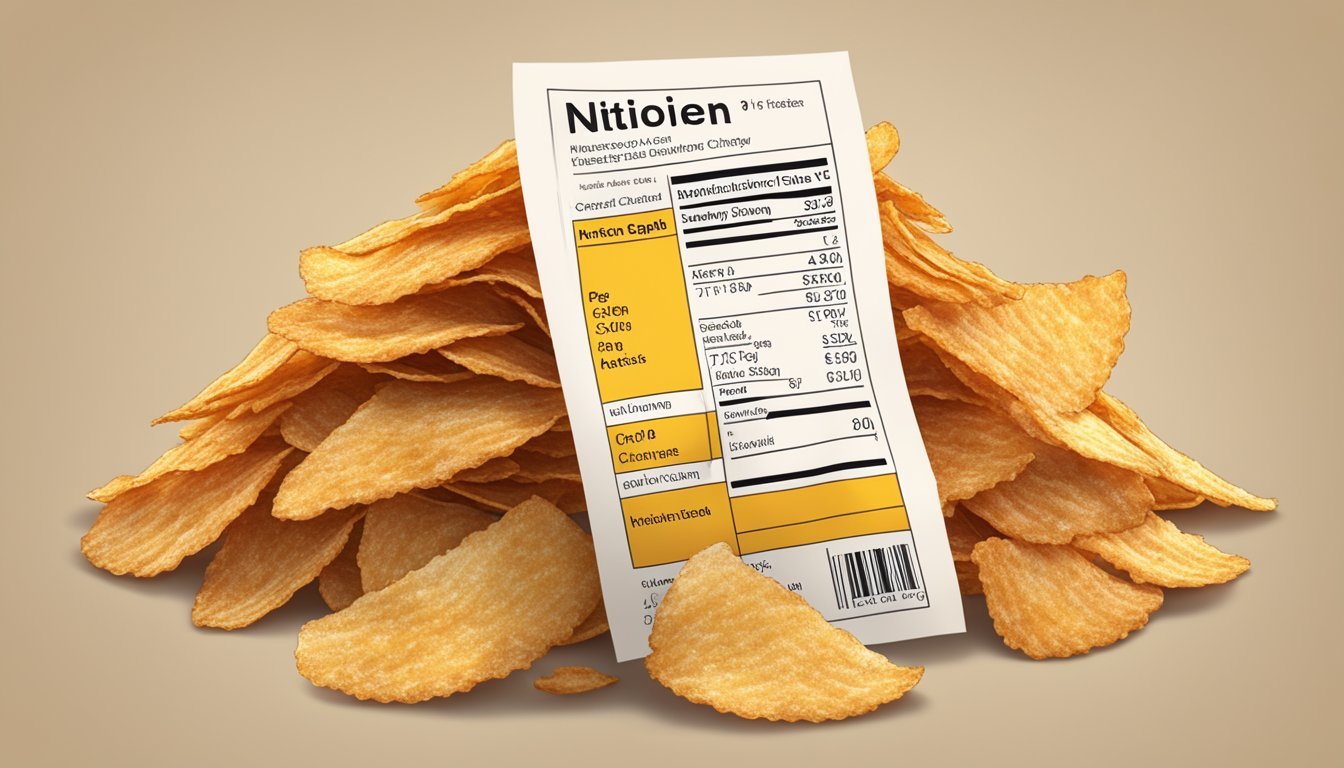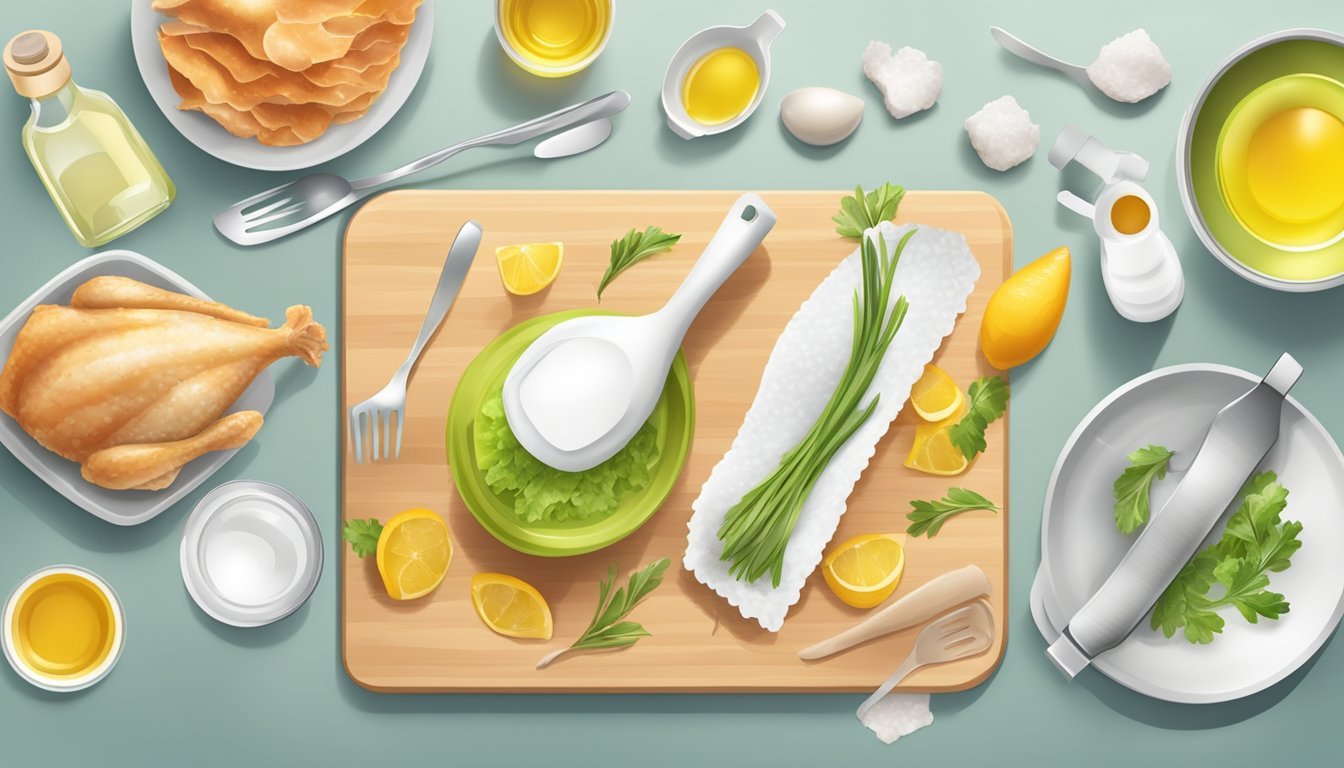How to Make Crispy Fried Chicken Skin Chips
A Step-by-Step Guide
Crispy fried chicken skin chips are a savory snack gaining popularity for their rich flavor and satisfying crunch. Often touted as a low-carb alternative to traditional potato chips, these snacks make use of chicken skin that might otherwise be discarded. The process of making them is straightforward, and with the right seasoning and cooking technique, they can be a delectable treat.
One starts by removing the skins from chicken thighs (What wine goes well with chicken thighs?) or breasts and patting them completely dry to ensure optimal crispiness. Seasoning plays a crucial role in the flavor profile of the chips. A blend of salt, pepper, and additional spices such as garlic powder, paprika, or onion powder can be tailored to personal taste preferences.
The cooking method can vary, but the goal remains the same: to achieve a golden brown, crispy texture without burning. This can be done in an oven, air fryer, or even in a pan, positioning the skins in such a way as to avoid overlap and to facilitate even cooking. The end result is a snack that's not just tasty but also resourceful, as it utilizes an ingredient that might otherwise be overlooked.
Ingredients and Preparation
To ensure the perfect batch of crispy fried chicken skin chips, one must carefully select the best chicken skin, gather specific seasonings and spices, and follow precise preparation techniques.
Selecting Quality Chicken Skin
Selecting high-quality chicken skin is crucial. It should be fresh, with no signs of discoloration or damage. Ideally, the skin comes from organic or free-range chickens due to their higher quality and flavor profile.
Gathering Necessary Ingredients
The ingredients for crispy chicken skin chips are simple yet impactful. Here is a list of what one will need:
Chicken skin: 1 pound
Kosher salt: 1 teaspoon
Paprika: 1/2 teaspoon
Garlic powder: 1/4 teaspoon
Onion powder: 1/4 teaspoon
Black pepper: 1/8 teaspoon
White pepper (optional): 1/8 teaspoon
Cayenne pepper (optional for heat): 1/8 teaspoon
**Non-stick cooking spray or oil (for coating)
Prepping the Chicken Skin
To begin, the chicken skin requires thorough cleaning and patting dry with a paper towel, ensuring no excess moisture remains. Then, one must scrape off any remaining fat. After removing excess fat, the skin should be cut into uniform strips or pieces, which will promote even cooking and crispiness. Once cut, the skin must rest, preferably in a refrigerator, to dry out further, which aids in achieving the ultimate crispness when cooked.
Cooking Methods
Properly preparing chicken skin chips can be achieved through various cooking methods: baking in the oven, using an air fryer, or pan-frying. Each method has its distinct process and can yield deliciously crispy results when followed carefully.
Baking in the Oven
To bake chicken skin chips in the oven, one must first preheat their oven to a certain temperature—typically around 350°F (175°C). The chicken skins should be laid flat on a baking sheet lined with parchment paper to prevent sticking and ensure an even crisp. A second piece of parchment paper, followed by another baking sheet, can be placed on top of the skins to retain flatness. Baking time may vary, but a general guideline is 30 minutes or until the skins achieve a golden brown, crispy texture.
Using an Air Fryer
An air fryer is a popular and efficient tool for achieving crispy chicken skin. Preheating is usually not necessary, and the skins can be placed in a single layer inside the air fryer basket. The cooking time is typically shorter than oven baking, with the chicken skin often achieving desired crispiness within 15 to 25 minutes, depending on the air fryer's model and temperature settings.
Pan-Frying
For pan-frying, one should choose a suitable pan and a moderate amount of oil to cover the bottom. The chicken skins need to be added to the hot oil and allowed to cook at a high simmer, ensuring the skin remains flat. They should be cooked until all the water evaporates, and then the heat should be reduced to achieve an even golden-brown texture. The cooking process usually requires attentive heat management to prevent burning while rendering the fat, resulting in a uniformly crispy skin.
Seasoning and Flavoring
The right combination of seasonings can elevate the simple chicken skin chip to a flavorful snack. The choice of spices and herbs, along with their proper application, ensures each bite is packed with flavor.
Choosing Your Seasonings
When selecting seasonings for chicken skin chips, it's essential to start with a base of salt and black pepper. These basic seasonings form the foundation of any good spice blend. To add warmth and color, paprika is often included. For those seeking a spicy kick, cayenne pepper and chili powder deliver heat without overwhelming the palate.
For further complexity, one might consider aromatic herbs like parsley, while blends of dried herbs and spices can be tailored to personal taste or to complement accompanying dishes.
Classic Seasoning Blend Spicy Kick Mix Herbed Delight Salt Cayenne Pepper Dried Parsley Black Pepper Chili Powder Mixed Italian Herbs Paprika Black Pepper Salt
Applying Seasonings Evenly
The key to maximal flavor is even seasoning application. Chicken skin should be patted dry and laid flat, allowing the spices to adhere better. A small bowl can be used to mix equal parts of salt, pepper, paprika, and any additional spices or herbs. This mixture should then be sprinkled or rubbed onto the chicken skin to ensure it covers every part.
One can employ either a shaker for a lighter, more even dusting, or fingertips can be used for rubbing in the seasonings for a more integrated flavor. If one chooses to post-season, adding spices while the chips are still hot from cooking can help the seasonings to stick better due to the residual oil on the surface.
Serving and Storage
Crispy chicken skin chips offer a delightful crunch and rich flavor, making them an ideal snack or crunchy topping for a variety of dishes. Proper service and storage techniques ensure they remain as tasty and crispy as when first made.
Serving Suggestions
Crispy chicken skin chips can be savored on their own as a snack or utilized to enhance other culinary creations. They are superb as a garnish on soups and salads, adding a contrasting texture. Alternatively, for a hearty choice, one might use them in sandwiches to provide a crispy topping that complements the soft bread and fillings. To preserve their crispness, it's best to add these chips right before serving.
Storing for Freshness
To maintain the freshness and crispness of the chicken skin chips, proper storage is crucial. They should be kept in an airtight container to prevent them from becoming soggy due to moisture. It's advisable to store the container in a cool, dry place and to consume the chips within a few days, which ensures that their tasty quality is retained. If one must store them for an extended period, refrigeration can help to prolong their shelf life, though they may lose some of their crispness and may need to be re-crisped in an oven or air fryer before serving again.
Nutritional Information and Dietary Considerations
Crispy fried chicken skin chips offer a crunchy snack for those following specific dietary regimes such as keto or paleo. Due to the high-fat content and minimal carbohydrates, they align well with low-carb diets.
Nutritional Breakdown (Per 1 ounce/28g):
Calories: 126
Protein: 4.5g
Total Fat: 12g
Saturated Fat: Not specified
Carbohydrates: 0g
Sodium: Not specified
Cholesterol: Not specified
Sugars: 0g
They contain no sugar and negligible carbohydrates, making them a suitable indulgence for those on a ketogenic diet. However, due to the saturated fat content, moderation is key. The presence of protein contributes to the feeling of satiety.
As these chips are cooked by themselves without added ingredients, they are gluten-free, but they could be high in calories and saturated fats depending on how they're prepared. Individuals with dietary restrictions on cholesterol or those monitoring caloric intake should consider this when incorporating chicken skin chips into their diet.
Unfortunately, specific amounts of sodium, potassium, calcium, iron, vitamin A, and vitamin C are not usually provided for chicken skin chips. The nutritional content can vary based on the preparation method and any additional seasonings used.
Although significantly lower in carbs than traditional potato chips, one should take note of the saturated fat and cholesterol levels, especially those at risk for heart disease. As a general approach, enjoying fried chicken skin in moderation can be a part of an overall balanced diet.
Pro Tips for Perfect Chicken Skin Chips
To ensure crispy chicken skin chips, there are several key steps one needs to take. Achieving that golden, crisp layer requires careful preparation and cooking.
Start Fresh: Utilize fresh chicken skin. Freshness is paramount to achieve the best texture and flavor.
Remove Excess Water and Fat: Pat the chicken skin dry with paper towels. Removing all excess water is crucial to prevent steaming when cooking. Then, trim any extra fat, which allows for an even, crispier texture.
The pros recommend the following steps in cooking chicken skin chips:
Lay the skin flat: Spread the chicken skins flat on your cooking surface to ensure an even crispiness. Skins that overlap will cook inconsistently.
Render the Fat: Rendering the fat is essential. Cook the chicken skins at medium heat to slowly melt away excess fat, leaving behind a crispy layer.
Watch for Curling: Chicken skins have a tendency to curl up as they cook. To avoid this, one can place another pan on top to keep them flat during the initial cooking phase.
Season While Hot: After the skins are crispy, immediately season them. The residual heat helps the seasoning stick better, ensuring a flavor-packed bite.
Cool on Paper Towels: Transfer the cooked skins to a plate lined with paper towels. This helps to absorb any rendered fat, leaving behind the perfect chip.
By following these pro tips, making chicken skin chips becomes an easy and rewarding process, providing a deliciously crispy snack every time.
Alternative Uses and Recipes
Crispy fried chicken skin chips serve as a versatile ingredient that can elevate both traditional and modern dishes with their rich texture and flavor.
Homemade Chicken Cracklings
Fried chicken skin can be transformed into homemade chicken cracklings, a delightful snack that rivals the classic pork belly (What wine goes well with pork belly?) cracklings. Preparing homemade chicken cracklings involves boiling chicken skins to render out fat, followed by baking or frying until they achieve a golden-brown crispness. These can be seasoned with a variety of spices to create a paleo-friendly snack.
Innovative Serving Options
Chicken skin chips can be creatively used in numerous dishes for added crunch and flavor. One can sprinkle them over Brussels sprouts for a twist on a roasted vegetable side, or incorporate them into Taiwanese popcorn chicken for an extra crispy dimension. Here are some distinct serving suggestions:
Chicken Wings: Dust chicken skin chips over wings for an additional crispy layer.
Chicken Skewers: Wrap skewers with chicken chips before grilling to enhance texture.
Guacamole: Use chicken chips as a novel, gluten-free dipper in place of traditional tortilla chips.
Potatoes: Garnish mashed or baked potatoes with crushed chicken cracklings instead of bacon bits.
It should be noted that while fried chicken skin is delicious, it should be consumed in moderation due to its high fat content.
Safety and Cleanliness During Preparation
When preparing crispy fried chicken skin chips, it is crucial to maintain a clean and safe environment. Kitchen safety should be the top priority, as mishandling of chicken skins can lead to cross-contamination.
Cleaning: Before beginning, one should thoroughly cleanse all surfaces, including cutting boards and countertops, with a reliable disinfectant. Hands must be washed with warm, soapy water for at least 20 seconds before and after handling raw chicken skins.
Chicken Skins Preparation:
The chicken skins should be carefully separated from the meat, if not pre-purchased as skins only.
It's recommended to trim any excess fat to ensure even crispiness.
Drying:
Patting the chicken skins dry with paper towels is an important step; it aids in achieving the desired crispiness.
After using paper towels, dispose of them immediately to prevent any potential contamination.
Utensils and Plates: Utilize separate utensils for handling raw and cooked chicken skins. Ensure plates or containers used during the preparation are kept separate: one for raw and another for cooked skins.
Cooking Caution: Hot oil can splatter, so maintaining a safe distance and using long-handled utensils can prevent burns. Always monitor the heat to avoid oil reaching a point where it may produce harmful smoke or catch fire.
By following these safety and cleanliness guidelines, one can assure a safer prep stage for making crispy fried chicken skin chips. Remember, a cleaner cooking process not only helps in creating a delicious snack but also ensures overall well-being.
Conclusion
The process of creating crispy chicken skin chips is a culinary craft that rewards patience with a delicious and satisfying crunch. They are a delightful snack that allows chefs to utilize what might otherwise be discarded, turning simple chicken skin into a delectable treat.
Key Takeaways:
Dryness is Crucial: Pat the skins dry. Moisture is the enemy of crispiness.
Seasoning Works Best Post-Cooking: Sprinkle the spice blend on immediately after frying while the skins are still hot for optimal flavor adhesion.
Proper Cooking Method: Whether using an oven, air fryer, or pan, ensure to cook at an adequate temperature to render the fat and crisp the skin without burning.
For best results:
Store in an airtight container to maintain crispness.
Enjoy them soon after cooking, as they taste best when fresh.
They can be enjoyed on their own or used as a creative garnish to add both texture and flavor to a variety of dishes. The simplicity of the ingredients and the cooking process belies the complex layers of flavors that can be achieved through careful seasoning and attentive cooking. Chefs should experiment with different spices to tailor the chips to their unique taste preferences or the demands of accompanying dishes. Enjoy the homemade crispy chicken skin chips as a testament to culinary innovation and the joys of a kitchen endeavor.





